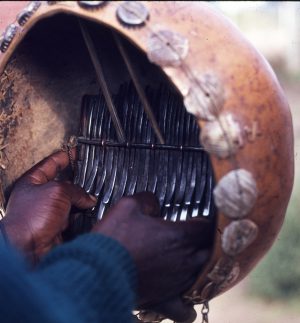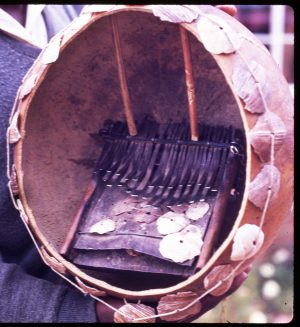The njari is a less common type of Shona mbira originally introduced from Mozambique. It was quite popular in Zimbabwe during the mid-20th century, and frequently featured there in radio shows during the 1950’s and 1960’s. There are still a few people playing njari in Zimbabwe today, and MBIRA hopes to record them in the future.
Njari audio sample:
Recordings Available From MBIRA
CD/Download 1200. Njari 1971: Alvoro Shiwoto & Enoch Kaute
History of the Njari
(by Hugh Tracey, 1932, citation below, notes in italics added for this site)
“The history of the njari is bound up with the origin of the Njanja sub-tribe. It is briefly as follows:
Between 150 and 250 years ago (note: as of 1932), a party of traders came through this country (note: Zimbabwe) coming from the Portuguese country of the Zambesi Valley (note: Mozambique). Amongst them was a Portuguese-MuNyungwe man called Muroro. When they arrived in the district of Chief Chirgwa, in what is now called the Buhera district, Muroro fell sick, and was left to his fate with a few of his trading goods by his companions, who returned presumably to the Zambesi Valley in Portuguese territory. The daughter of the chief, however, took pity on him and nursed him back to health. Whereupon he married her.

This was not looked upon with sympathy by her father Chirgwa, and he would have had the foreigner put to death had he not been stopped by the Mambo, the “King” or Paramount Chief, who lived at Zimbabwe, Fort Victoria (now Masvingo) district. When the old Chief died, Muroro, who was trading in the vicinity, informed the Mambo before the sons of Chirgwa did so. This was a grave breach of custom on the part of the Chief’s sons, who should have seen to it that they themselves brought the news of their father’s death. The Mambo was so incensed that he gave the inheritance of the Chieftainship of Chirgwa to Muroro, who then took the name of Gambiza, and the mutupo or surname of Senhor, now called Sinyoro, as he had no African family name, from his mother’s family. There were two sons born to this man by his wife, the daughter of Chirgwa, Mesama and Gotowi.
When these boys grew up their father sent them to visit his relations in Portuguese territory. There they met with men playing on an instrument called the Njari, and were so pleased with it that they both learnt the art and on returning to Buhera brought it with them. The people of the Buhera district had long been noted for their blacksmithing, and they soon manufactured numbers of these instruments and began to hawk them round the countryside. The tone was new to the people and the skill of the two sons of Gambiza considerable, and so they earned for themselves the nick-name of Manjanja, a word indicating the sound of the njari. Thus, the njari was christened the Njari dzaManjanja. Its success was immediate and the whole district took it up, often playing tunes that were brought in by Mesama and Gotowi from the Zambesi Valley. By 1900 A.D. the instrument had spread about 100 miles in all directions from Buhera, having reached the Mrewa (now Murehwa), Rusapi (now Rusape), Bikita, Victoria (now Masvingo), Chibi (now Chivi), Chilimanzi (now Chirumanzu), and Salisbury (now Harare) districts. It did not, however, get to Mtoko (now Mutoko) until about 1910 A.D. and has not yet (1932) arrived in the Darwin area, nor on the east side of the Sabi (now Save) River or apparently further south than the Lundi river or the line 20 degrees South Latitude.

The exact position of its origin in Mozambique was not known, but it was said to have come from the Nyungwe area of Tete. The name Tete is popularily given to the whole of the district between Tete itself and Chikoa, further up the Zambesi Valley. It was not until my last week in the field that I met a man from this country, playing an Njari from the Valley, in fact, playing one of the tunes with which I was already familiar in the Njanja country, though I had previously met several Nyungwe njari musicians playing quite a different class of tune. This musician, Kabango, is a Mutawara, and he informed me that he thinks the njari originated with the WaDema people who lived up in the hills near Dzunsha, a day’s march east of Chikoa, under the chief Songo, near chief Nyampandu. Unfortunately I have been unable to verify this data, but am prepared to believe, both from the shape of his instrument and the tune he played, that the real home of the njari from which the sons of Gambiza brought it must have been in this vicinity.
My informant as to the history of this instrument was old Chief Chabkanya, called Machakairi (who was, he said, the son of Chabkanya—the son of Makumbi—the son of Neshangwe—the son of Masoka—the son of Mesama—the son of Muroro Gambiza (six generations)). He himself is now about 75 years old. This would make the probable date for the introduction of the njari not later than 1755 A.D., and possibly as early as 1680 A.D.
In the light of Professor Hornbostel’s theory, it is interesting to note that this instrument has ritualistic significance, both with the Mashavi and Midzimu. Its association with the Mashavi concept being of later date is not surprising, but its introduction into the cult of Ancestor worship along with the ancient Mbira dzeMidzimu can only be accounted for by mental association and the fact that it is often called by the general term “Mbira”, he notes.
This instrument, although it may have originally been introduced with the Tawara or Nyungwe scale has not kept to that tuning, but has followed the local preferences of each sub-tribe. It may be that each sub-tribe was attempting to attain the mode of the Manjanja, but their consistent failure to do so, coupled with the fact that it is never in the same mode as the Mbira DzeMidzimu (note: also known as mbira dzavadzimu or just mbira) throws considerable light upon the whole subject of tribal modes, and the foundations of Shona music.
Njari duku. This instrument occurs in the Mtoko district, and is a small version of the njari. It, however, is not tuned the same and appears to be a direct intrusion from the neighbouring Nyungwe people, and a relation of Nyungwe Kambira.”
This njari history is reprinted by permission from the International Library of African Music (ILAM), from:
Tracey, Hugh. “The Mbira Class of African Instruments in Rhodesia.” African Music Society Journal (1932): 87-91.